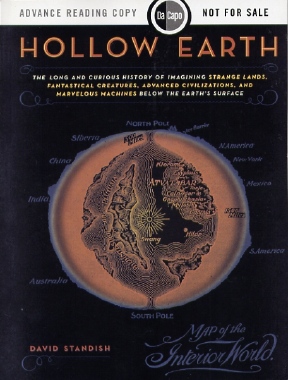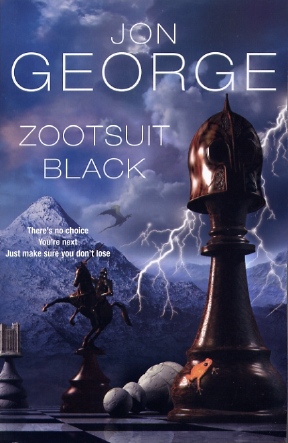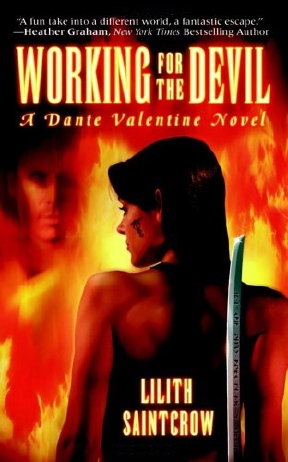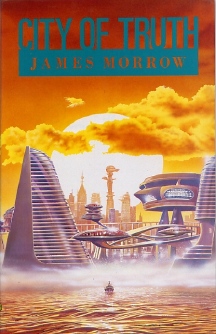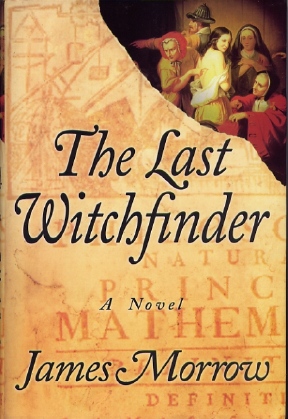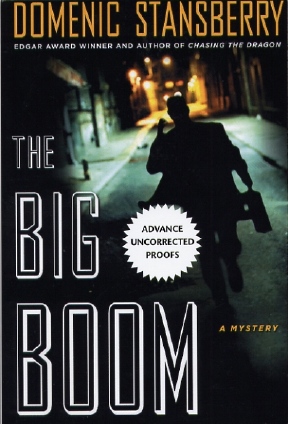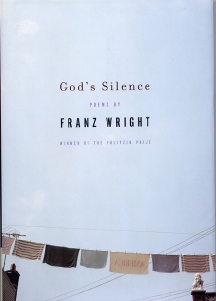|
|
|
This Just In...News from the Agony Column
|
04-21-06: David Standish Excavates 'Hollow Earth' |
|||
The
Stories Beneath the Surface
I've long had a special fondness for stories about the Underworld since I first encountered the so-called Shaver Mysteries, the wild stories of Richard Shaver published by Ray Palmer, in Amazing Stories in the early 1940's. But these wild tales of aliens and monsters controlling the world were really the last in a long line of tales of strange doings beneath the crust of the earth. From the time Sumerians first imagined the Underworld to the Kennedy assassination to the tapes of the screaming damned below, we've known that the appearance of the earth as a solid body was simply that; mere appearance. There had to be, there has to be something beneath. David Standish collects our beliefs about what lies beneath in 'Hollow Earth' (Da Capo / Basic Books ; July 2006 ; $24.95). If you’re like me and you love hollow earth "fact" and fiction, this is the essential guide to our beliefs, our stories, our imagination of the worlds beneath our feet. 'Hollow Earth' is one of those books that gets right to the good stuff. Standish, a journalist published in the stratospheric realms of Smithsonian, Audubon, Esquire, and Outside, gets down to earth and beneath starting in 1691 with Sir Edmund Halley. Yes, the comet guy had a very interesting idea as to what was going on beneath our feet. Halley proposed three concentric spheres, one within the other, much like the beloved matrushka Russian nesting dolls that show up as a motif in fiction as varied as David Mitchell's 'Cloud Atlas' and Cory Doctorow's 'Someone Comes To Town, Someone Leaves Town'. Halley, who had helped bring Sir Isaac Newton's Philosophiae naturalis principia mathematica to publication, based his concepts on those in Newton's work. And thus from the beginning, Hollow Earth stories combined bits of fact with wild-hair speculation to create elaborate visions of worlds within worlds. Standish's tack is to document two sets of facts; the science that was behind the wild speculations, and the wild speculations themselves, as well as the even wilder fiction they inspired. Oh, yes, Standish does not leave our favorite fictions out of the equation. Edgar Allen Poe, Jules Verne, Edgar Rice Burroughs, even Rudy Rucker each get chance to approach the lectern. Equally interesting and imaginative are the so-called theoreticians who march across Standish's stage, from Captain John Cleves Symmes, who declared to earth to be hollow and the interior to be habitable, to Cyrus Teed who discovered the Philosopher's stone long before a certain schoolteacher and went on to summon God and combine astronomy and geology when he declared that not only was the Earth hollow, but we were living in the Hollow Earth. As ever, fact is stranger than fiction, and just as entertaining when filtered through the writerly talents of someone like Standish. Appropriately, as far as I'm concerned, Standish climaxes his book with a look at the Shaver Mysteries. Shaver was a science fiction writer who wrote what he originally termed to be science fiction about the Deros, who lived within our world but secretly controlled life on surface. Later, he changed his tune and declared fiction to be fact, showing his innate skills as a politician. The story of Shaver and his editor at Amazing Stories, Ray Palmer is the stuff of Internet Legend. Indeed, should you desire to make the following hour evaporate into the mists of time, pop over to Shavertron and get lost in Shaver's and Palmer's weird but crowded-with-busty-damsels-in-distress inner worlds. That is of course the focal point of all this theorizing, and Standish's book serves as a perfect history. This concept of the hollow earth, and the evolution of this concept, tells us more about ourselves than it does about the world around us. When we look at someplace we can never really travel and say, "Here be monsters," why, those monsters will bear a suspicious resemblance to what we see when we look in the mirror. Maybe the funhouse mirror, sure, but that's just a way of seeing what's really inside -- our emotions -- wrought at large upon our smiling faces. Sure, on the outside we're smiling. But on the inside? We're hollow. Inhabited by monsters, damsels, and fears we cannot name, but here, at least, we can read about them. And begin to get a grip. |
|
04-20-06: Jon George Is Wearing 'Zootsuit Black' |
|||
Pawns
of the Realm
H. P. Lovecraft understood this implicitly, as is reflected in the justly famous (and oh-so-identifiably verbose) quote that opens 'The Call of Cthulhu': "The most merciful thing in the world, I think, is the inability of the human mind to correlate all its contents. We live on a placid island of ignorance in the midst of black seas of infinity, and it was not meant that we should voyage far." Philip K. Dick understood this as well; "Reality is that which, when you stop believing in it, doesn't go away." What these writers were getting at is the idea that our very sanity depends on a stable (if sometimes unfriendly) reality. And as writers, they both knew quite well how to exploit that truth, to use it to create fear. Both men loved to put cracks in reality to suggest that it wasn't, as the wags say all it’s cracked up to be. With the catch that, once you understood that, it was time to be afraid. Thus are science fiction and horror joined at the hip, at their birth, the two genres intimately intertwined. But horror, as we're talking about it in this case, is not the stuff that the Marketing Department means when it refers to horror. This is not the horror of Stephen King, but rather the existential horror of Jean Paul Sartre in 'Nausea', as well as Philip K. Dick's voyages into paranoid terror. This feeling that things are not as they seem, that the rug could be yanked out from underneath us at any moment, our reality replaced with something much less friendly, is truly the stuff of nightmares. What frightens us most in dreams are not the images of death, but rather the perception that the logic of the world we know has come undone. Those dreams continue with 'Zootsuit Black' from Jon George (Tor UK / Pan Macmillan ; May 5, 2006 ; £10.99). George started his career for Tor UK with 'Faces of Mist and Flame', a twisty tale of time travel and World War Two. With 'Zootsuit Black', it appears, he's not left either far behind, though the mix is now decidedly more unsettling. The premise here is alarming but not simple. The Shift is coming, and it's not a car commercial. Reality will be rewritten and in a manner much less friendly to homo sapiens. The countdown is here. Seven days. Dr. Jake Cruz has figured out that humans have about that long to stir up their nascent psychic powers. Scott Anderson finds himself enmeshed in a "vast, right wing conspiracy." Nice how even science fiction imitates life, no? Both men find themselves unstuck in time, and they're the lucky ones. The Nazis, the dragons, well, we'll muddle through, won’t we? Won't we? That depends both on how optimistic you are and how optimistic Jon George is. Take a look around. Are you optimistic? Take at look at George's premise that we're all about to die a lot sooner than we expected. Do you think he's optimistic? Do you feel lucky? Then you might want to order this one up, for another dose of the Second World War through a weird filter, this time with monsters. Then you can sit down and read it. If you are in fact lucky. If things don’t change, suddenly, radically. Permanently. |
|
04-19-06: Lilith Saintcrow is 'Working for the Devil' |
|||
| Hide
the Brain Candy by Terry Weyna
There’s a whole other category, though; books that you wouldn’t want anyone on the subway to catch you reading, and that you shove under the couch cushions when your sweetheart walks into the room. These books are guilty pleasures. They require no brain work at all beyond the effort to move your eyes from left to right. They can be read in an hour or two, cover to cover. You don’t expect – and you certainly don’t find – exciting prose, fully formed characters, or a plot that makes sense. What’s on offer is fast reading, a story you don’t have to think about – indeed, it helps if you don’t think about it, because otherwise it seems kind of silly – in short, pure brainless entertainment. It’s like eating that entire chocolate Easter bunny in one sitting. A subgenre of romantic horror has developed in recent years that fits squarely in the guilty pleasure category. Some of it can be quite good, like the early Laurel Hamilton novels. Some of it amounts to nothing but Harlequin romances with monsters included. And some falls in between, solid efforts often by first-time authors, like 'Working for the Devil' by Lilith Saintcrow (Warner, $6.99, March 1, 2006). 'Working for the Devil' features Dante Valentine (the heroines of these novels – and they’re almost always heroines – always have amazingly romantic names, as, indeed, the authors seem to as well), a Necromancer – that is, someone who can talk with the dead (a trait shared with the Violets of Stephen Woodworth’s novels, about which more soon). The story isn’t about her ability to speak with the dead, however, but with the fact that that ability makes her something not quite human and not quite demon, and therefore the perfect person to assassinate a demon who has escaped from Hell. Lucifer himself hires her, after having had her escorted to Hell for a job interview by a gorgeous green-eyed, golden-skinned, human-shaped demon known commonly as Japhrimel (not his full name, of course, because knowing a demon’s full name gives you complete power over him; only Dante learns it in the course of the book). Dante is not a nice person. She is tough, sarcastic, bitter, and unpleasant to friends and enemies alike. She’s a bitch on wheels to her ex-sweetheart, who, it turns out, left her in order to save her life when his family – one of the crime families that appears to rule this world – decided she had to go. She’s not particularly friendly to her friend Gabe, a police officer who assists her in tracking the demon, who coincidentally happens to be the head of the very same crime family that Dante’s ex saved her from. She’s downright horrible to the demon who has been assigned by Lucifer to protect her, despite the fact that she feels (of course!) strangely attracted to him. The novel is violent, with fights breaking out here and there for no apparent reason except to allow us to imagine the blue light flowing along the blade of Dante’s sword, the gleaming of the emerald embedded in her cheek, and the charge of Power in the air around her. The plot is slower than it ought to be; where political complications could rear their ugly heads, or relationships develop, instead we have incident – another visit to another sort of oddity who can provide information through another mystical means, for instance, or a ride on a “slic,” a sort of skateboard that flies. Despite the numerous flaws in this novel, I kept reading. No, I didn’t read it on the bus; I read it while I was holed up in my home on a rainy reading vacation, where no one had to see the flaming red and yellow cover featuring a gorgeous long-haired woman and a shadowy man (really, a handsome demon, as all romance readers know that men really are) in the background. I felt guilty to be reading such delicious trash, but it was just as pleasurable as the pizza I ate while I read it. Really, what other kind of book goes better with pepperoni? |
|
04-18-06: James Morrow Seeks 'The Last Witchfinder'; Domenic Stansberry Hears 'The Big Boom' |
||||||
Not
Just Another Godhead
Nothing like an old man gathering wool. In this case, the wool includes James Morrow's 'City of Truth', the Century Legend novella that is screamingly funny, horrific and heartrending. All at once. Morrow is a unique talent, and apparently, one whose books I was able to find pretty quickly in the stacks. I loved 'This Is How the World Ends', a very funny look at atomic war and as for the Godhead trilogy -- what more could you ask for than this? In 'Towing Jehovah', God has up and died. His corpse has fallen into the Atlantic, and the disgraced captain of an oil tanker that ran aground, fouling the environment, is asked to tow the divine body to the Arctic, to preserve him from sharks and decomposition. In 'Blameless in Abaddon', the decomposition problem has been solved, and the body has been turned into a theme park in Florida. And finally, 'The Eternal Footman', when all that remains of Our Lord -- his skull -- is launched into a geosynchronous Earth orbit, a plague of "death awareness" sweeps the globe. What makes these novels so remarkable is that Morrow always and ever remains utterly true to his premise. He makes the utterly fantastic utterly real. You believe that God's corpse presents a logistical challenge for the Divine tugboat. Morrow never descends into cartoonish satire even as he savagely rips just about every cultural institution a new one. His prose style is pitch-perfect. You never doubt or find yourself thrown out of the book. He's a remarkable writer and a remarkable resource.
Morrow brings years of research to bolster his ample and rich imagination, and the result is a lush, atmospheric novel filled to the brim with philosophy, characters, events real and imagined, lives and beings real and imagined. This is Morrow's longest and most complex novel yet, and easily the novel with the widest appeal. His skewering sense of humor is in full bloom, and ability to create real humans to muddle through a world that is unreal both to them and to us is better than ever. For readers who loved his last novels, all the humor and all the complex characters are once again in evidence. But more importantly for Morrow, this novel has a potential appeal that a novel about 'Towing Jehovah', no matter how good, just can't match. Historical fiction has been hot since Caleb Carr gave us 'The Alienist' (not that there weren't exemplars before this, or that Carr is the only game in town; he's just the game that snagged my attention). Morrow's 500-plus page take has all the nooks and crannies that make the genre so strong, and Morrow's talent to boast as well. HarperssCollins has done an excellent job making 'The Last Witchfinder' look classy, smart and engaging, which it surely is. And with Morrow writing, it's certain to be subversive and consistently witty as well. In fact, though this is the first book by Morrow that is not about God in many years, as we know, God is in the details. This novel by Morrow, then, becomes a part of the Godhead (if not the Godhead trilogy) by virtue of Morrow's ability to wield the wickedest details with deadly precision. One need no further example of how far Morrow has come in seven years than the fact that this, his latest novel, will be found shelved with general and historical fiction, not scuttled away with the science fiction. Seek 'The Last Witchfinder', and prepare to have Morrow pleasantly destroy days of reading. |
||||||
Dante
Mancuso's Return
Mancuso is a classic noir detective. Ex-cop, who following his father's death, moves back home but not into the family home. His father's house remains unsold, and Dante is holed up in a North Beach over-the-garage apartment. He's working for "The Company", a shady security firm that straddles the law with alarming ease in these security-conscious times. When a woman's body washes up after four or five days in the bay, it's not clear who she might be. What is clear is the prose that Stansberry brings to bear as Mancuso finds out who did what to whom and why. No, it's never as simple as it sounds, is it? Stansberry writes with such effortlessness that you'll be floating as well, on a sea of prose that glitters, grabs and gets to the grit. This is the kind of novel that you pick up in the store and finish four chapters before you manage to look up and sense the setting sun. It's dangerous enough that it's actually mid-afternoon here, and I'm usually wrapping up my writing before the sun has fully risen. The boom in question is the sound of venture capital exploding as men who have too much money invest in the hopes of getting even more. The North Beach streets are the haunts of the Silicon Valley elite, and the San Francisco Bay is a good place to dispose of that which stands between you and The Next Big Thing. But no matter what the subject, the object of Stansberry's writing is to immerse the reader in the tar-baby plastic-wrap of a pitch-black tale of transparent greed. Oh the delight. Oh the dessert. It is served. Dive in. Don’t count on getting out. |
|
04-17-06: Franz Wright Breaks 'God's Silence' |
|||
"Literature Will Lose": A 2006 Conversation with Franz Wright and
Kathryn Petruccelli
But the facts are never either obvious or easy. Rarely are they even demonstrably factual, actual. One of the most common homilies we hear of late is how religious America is, how many of us have this faith or that faith. The fact of faith is fine and undeniable. The statistics of faith, however, are another matter entirely. When you read the word "faith" in the news, you're likely to see it accompanied by an image of someone in a big ol' Church-with-a-capital-C. But the people I know -- admittedly a skewed sample -- are not so commonly found parking their keesters on pews. Sure, we all have faith of some kind or another, but precisely what kind is a matter that can only be determined on an individual level, one conversation at a time, and even then, only at the time of the conversation in question. Step out the door and your faith is going to undergo a change that can range anywhere from subtle to radical. Let's leave our faith then, to the poets. With the exception of those religions that start out and end up as $cience fiction, most religious literature is poetry. In the case of Franz Wright, the opposite is true. 'Gods Silence' (Knopf / Random House ; March 2006 ; $24) offers poetry that lives in the same mental places usually reserved for religious thoughts. No, Wright isn't pushing any particular faith beyond a faith in the ability of language, specifically poetry, to help us wrap our brains around the spaces between the facts of our everyday lives. Wright, who won a Pulitzer Prize in 2004 for his collection 'Walking to Martha's Vineyard', is back this year with a new collection of luminous words. With his latest work, he continues to demonstrate that he is his father's son -- and in this case, his father is James Wright, one of the most important figures in American twentieth century poetry. Wright allows that his father was, " a difficult act to follow." And with 'God's Silence' he shows that he's found faith, at least in his words. Wright's latest collection does what poetry and religion both do best, and does so in a manner as to make the difference between the two negligible. This intersection is of particular interest to readers who might have found interest not in the religions of this world but in those created in the world of words, the world of fiction. For example, in "Prescience" he writes: We speak of Heaven who have not yet accomplished even this, the holiness of things precisely as they are, and never will! This is the kind of statement that a scientist studying brain activity during a religious experience might express, well, if the scientist were a poet. The best poets -- and Wright is clearly one of them -- don't write words that come off necessarily as poetry. Time after time, in 'God's Silence', Wright manages to use his words to scratch away at the skin of existence, to use words to get at our lives in ways that neither fiction nor non-fiction can manage, to get at the core of the religious experience with the clearest and best language one can imagine -- but need not, as Wright supplies what is only in hindsight obviously called for. I am fortunate enough to work with some wonderful readers and interviewers at KUSP. While I enjoy poetry, I asked Kathryn Petruccelli, KUSP's resident poetry expert to speak to Wright, because I knew that she could do a better job bringing out the poet's experience in an interview. My readers and listeners can thank her and KUSP for the wonderful podcast interview that I'm running this week. Those who don’t subscribe, can download either the MP3 or the RealAudio file here. I'm privileged to have both players on my podcast and website. As for the battle for the facts and statistics about who believes what and why, well, the scientists will surely soon perform an obvious experiment. They'll run a brain scan of someone reading religious literature and someone reading poetry, and it's my bet that the brain maps will light up in the same places. The two experiences will prove to be indistinguishable and interchangeable. Remember of course, that both are subsets of what I personally consider the holy of holies, which is reading. Wright understands this as well. Literature, he knows, is a pure experience that leads us back to pure experience. "Literature will lose, sunlight will win, don’t worry." What is religion but words to live by and what better words to live by than these? |
